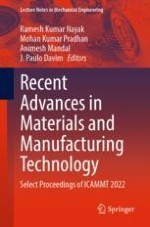This book presents the select proceedings of the 2nd International Conference on Advances in Materials and Manufacturing Technology (ICAMMT 2022). The book covers the latest trends in existing and new materials, manufacturing processes, evaluation of materials properties for the application in automotive, aerospace, marine, locomotive, automotive and energy sectors. The topics covered include advanced metal forming, bending, welding and casting techniques, recycling and re-manufacturing of materials and components, materials processing, characterization and applications, multi-physics coupling simulation, and optimization, alternate materials /material substitution, thermally-enhanced processes, and materials, composites and polymer manufacturing, powder metallurgy and ceramic forming, numerical modeling and simulation, advanced machining processes, functionally graded materials, non-destructive examination, optimization techniques, engineering materials, heat treatment, material testing, MEMS integration, energy materials, bio-materials, metamaterials, metallography, nanomaterial, SMART materials and super alloys. In addition, it discusses industrial applications and covers theoretical and analytical methods, numerical simulations and experimental techniques in the area of advanced materials and their applications. It also covers the application of artificial intelligence in advanced materials and manufacturing technology. The book will be a valuable reference for researchers and industry professionals alike.
